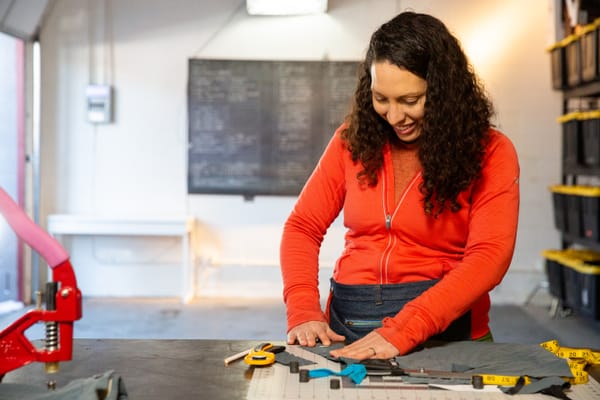Eating in California, Puerto Rican style
When I moved to California for college, I seriously missed my Dad's cooking. His cooking... is great. It's really the best.
So he sent me a few recipes, just so I could start cooking on my own. I've been using them for years now, and now my friends are asking for the delicious details!
The following are the entire contents of the Word doc that my Dad sent me back in 2004. I've left the content word for word, but have added my own formatting. (Dad jokes? What dad jokes?)
These recipes are near and dear to me, and I hope y'all get a chance to partake and enjoy some of the best food you've ever had in your life <3
Dude, this is the scoop! I was going to send you the recipe book I have in English but after looking through it, I think it sucks. Not only the translations are bad, it has different recipes. So I opted for sending some copies of the Spanish book and discovered that I do not follow it that closely anyway (I used to, though!). Therefore, pay attention because here it comes…
The secret is in the basics… Basic "sofrito" and basic "relleno". The basic sofrito is used everywhere you need to make a "guisado" (stew) such as "asopao", chicken stew, beef stew, "arroz con pollo", etc. The "relleno" is for the "pastelón", "empanadillas", "piononos", etc. and here they are.
Sofrito Básico (4-6 people)
1 onion (medium)
1 green pepper (the elongated kind)
4 cloves of garlic (about one per person)
1/2 teaspoon of salt
1/4 teaspoon of oregano
1/4 teaspoon of cilantro pinch on black pepper
6 to 12 olives (optional)
4 oz. of smoked ham (optional)
4 oz. tomato sauce
Olive oil and apple vinegar (the brown one, it's THE BEST)
1 packet of Sazón with achiote (optional)
2 pounds of meat
The onion and pepper should be finely chopped and the garlic should be minced to get the most flavor. To make it easier, you can use the already minced garlic that comes in jars. In that case, use a tablespoon of the garlic instead of the four cloves. You can’t go wrong with garlic.
In the same pot of your main dish, pour a few tablespoons of olive oil (enough to cover the bottom) and crank the heat up to 70% (med-high). I like to use ham for most dishes except fish so if you like to use ham, start with that and cook it until it browns. Throw in the onions, green pepper and garlic and a few drops of vinegar and let it sauté for a few minutes (5) and stir occasionally (do not let it stick to the bottom). During these five minutes throw in the rest of the ingredients. And that's it!
Actually, after the few minutes, you can throw in the meat (chicken, beef, pork, rice, yes even rice). For any meat, let it cook for a few more minutes (10 to 15) until the meat loses the reddish color. It is best if at this time you cover the pot and let it cook a bit, turning it. The rest is based on what you want done. TO BE CONTINUED…
Relleno de Carne Molida
Sofrito Básico
2 pounds of Ground Beef
Not much to say here, just use ground beef and let it cook at 40-50% (med-low to med) heat for 30 minutes.
These are the basics (the foundation). After this, the rest is a snap. But before we go on, we need the essentials, rice and beans. So rather than making it too complicated at first, let's do the "white" rice and the beans.
White Rice (4 people)
2 cups of white-rice
2 to 3 cups of water
1/4 teaspoon of salt
1 tablespoon of vegetable oil
2 oz salted pork (tocino) - optional
The "tocino" is optional but if you cannot find any, I sometimes use bacon (the most greasy one I can find). The idea is to fry the "tocino" (bacon) to get the fat out and use it to cook the rice. It gives the rice a nice smoky taste that Puerto Ricans love.
Anyway, after getting the fat out of the bacon, or not, pour the oil and let it heat up at 70% heat. Throw in the rice and the salt and feel like you are frying the rice. The rice will kind of roast a little bit (DON'T LET IT BURN!) while it starts to soak the oil/fat. While hot, throw in some water until the rice is covered by no more than 1/2 inch over the top. Too much water will result in happy-rice and too little will leave it uncooked. Again, this is a matter of trial an error. Stir after you reach the desired amount of water and let it cook "covered" for 10 to 15 minutes until the water is absorbed into the rice. You will know it is time when the rice is not boiling anymore and it is not spitting either (it is almost dry but not exactly). Once you get to this point, turn over the rice, lower the heat to 30-50% (low-med to med), cover it, and let it cook for another 30 minutes until done. You will need to turn it over once or twice during that period.
TIP: If you feel that you have too much water then leave the pot open so that some water will evaporate instead of being absorbed. On the other hand, if after the 10/20 minutes of cooking you notice the rice is not cooking (the grain is still whole, not split or hard) just sprinkle some water and continue the cooking until it splits.
Beans (the magical fruit)
1/2 Sofrito Básico
2 15oz cans of Cooked Beans
Simple… Substitute the beans for the meat and let it rip (simmer) for 30 minutes in medium to low heat. Just add another tablespoon of olive oil for flavor, a bit of water to make them fluid, and perhaps a diced potato. If you add potatoes, this will be your cooking time measurement (when the potatoes are soft using a fork, the beans are done). Also, do not forget to stir it occasionally. The heat level should be enough to get the stuff to a moderate boil (simmering). (Trial and error babe, just trial and error…)
OK… Now that we have the basics out of the way, let's add some meat, shall we?
Pollo guisado (4-6 people)
2 pounds of chicken parts (dark meat is best) without the skin
1 pound of potatoes (approx. 3 med size)
1 15oz can of diced tomatoes (optional)
1 carrot or other veggies (optional)
Sofrito Básico
A pinch more salt
Follow the recipe for the sofrito and use the chicken for the meat. Because of the meat type, you may need more salt so you either add a 1/4 teaspoon more or, better yet, sprinkle lightly the meat with salt. If you decide to use the diced tomatoes (which I recommend), add it with the chicken so they cook for a bit. After the last step of the recipe, when the chicken is pale looking (not reddish), add water until the chicken is covered. Note that the more water you add, the more soupy it's gonna get! So use your judgment…
After 20 to 30 minutes of simmering, dice the few potatoes and veggies and add them to the mix. Once again, the potatoes will determine when the stuff is done as in the beans recipe (maybe another 30 to 45 minutes).
Asopao de Camarones (4-6 people)
1 to 2 pounds of uncooked shrimp
Sofrito Básico
few drops of hot sauce (optional for kick)
1 cup of rice
water galore
Yes, that's right! Follow the sofrito recipe and replace the meat with shrimp. BUT, the shrimp cooks so fast that we need to hold them until the end. You should use the uncooked shrimps instead of the cooked ones (brown versus pink) because they will not get too gummy and you get more flavor.
Anyway, follow the sofrito recipe and use the rice instead of meat. Let the rice soak the juices a bit (5 minutes) and add water galore. I would say three times as much as when cooking rice (we are making soup, aren't we?). Put to simmer for about 30 minutes until the rice sponges and the mix starts to get the asopao consistency. You can now add the shrimp and cook for another fifteen or 30 minutes. You can add more water if it is too thick. Consider that asopao is more soup than rice and as it cools down it will get even thicker. THIS IS GOOD GRUB! ENJOY!
Arroz con Pollo (4-6 people)
1 to 2 pound of chicken parts (cut in halves if possible)
Sofrito básico
2 to 3 cups of rice (Uncle Ben's if possible)
1 red bell pepper (on sweet side) water
Kind of follow the directions for "pollo guisado" but hold the veggies including the tomatoes and add a red bell pepper. Simmer the mix half way (not to completion) for about 15 minutes, and add the rice. Now it is like making rice! Make sure that you have enough water to cover the rice and follow directions for cooking rice.
TIP: I like to use Uncle Ben's rice on non-white rice recipes because it is more forgiving when it comes to water. It takes a bit longer to split but I like the consistency at the end. More of a fluffy texture rather than a happy rice.
Mushrooms, I don-like-no-stinking-mushrooms. But I'm a fungi…
Sauté mushrooms
1 pound of mushrooms (a box)
1 onion
4 garlic cloves
Soy sauce
Apple vinegar
Olive oil
Nothing could be easier. Just finely chop the onions and mince the garlic. You can use the already minced garlic in jars (take a tablespoon or so). Garlic is GOOD!
In a frying pan, pour some olive oil and sauté the onions and garlic for a few minutes (no more than 2) with a sprinkle of vinegar. Add the mushrooms either sliced or however you prefer and add some soy sauce for flavor. If you are going to have the mushrooms as a side dish, you can cut the mushrooms in heads and tails. However, if you are going to use it as a base with steak or pork chops, then sliced works best.
Remember that soy sauce is salty so do not put too much (a tablespoon or so should be fine). Just use your nose on this one. You want some fluid consistency but not watery. Use both the olive oil and the soy sauce to get the consistency, while keeping the saltiness in check.
Meat with mushrooms
1 to 2 pounds of Meat
Sautéed mushrooms
Salt and pepper
When making meat with mushrooms (in a mushroom bed), I found that searing the meat first. Just slightly baste the meat with salt and pepper (no more than that) and throw in a pan with a little bit of olive oil. Do this on both sides until the surface of the meat loses its reddish color. Then take the meat away and in the same pan, sauté the mushrooms as in the previous recipe (just remember to slice the mushrooms). Once they are slightly sautéed (5 minutes), add the meat and let it cook in low to medium heat until the meat is done.
How about plantains you ask? Well, here are a few recipes…
Pastelón de Plátanos
2 pounds Relleno de carne (one of the basic recipes)
5 to 6 ripe plantains (big mamas not tinny winnies)
6 eggs
1/2 teaspoon of salt
1 15oz can of green beans (optional)
This recipe is good for a 9 by 13 by 2 baking dish, which could easily feed 8. A smaller dish will require the proportion of the dish volume (an engineer should know what this means).
The challenge of this recipe is the handling of the plantains. To start, they should be very ripe, almost at the point of going bad. To the touch this means, not hard, but firm (not mushy either). From the outside they look past yellow and perhaps turning black. Actually, if they are black, just squeeze them a little to check how firm they are (one more of those trial and error things).
Second, you need to slice them in at least four slices. This has a lot to do with the firmness of the plantains. If they are too soft, it is going to be a mess to slice (unless you have a slicer, such as a cheese slicer) but you can make thicker slices. If they are too hard, then it is easier to slice but you have to make thinner slices or else you are going to end up with leather in your dish. My trick is to have them in the soft side (not mushy) and slice them with a knife (I hate to clean the slicer afterward) with the skin on. First slice the plantain in half then slice the halves in half. Then take the skin off.
Third, you must fry the slices or else they will dry out when baked and they will not release their sweetness. So, take the slices and fry them slightly. Take them out when they get golden not brown and place them in a plate for later handling.
And now we are ready for the construction of our masterpiece.
Make the meat filling as per the recipe if you have not done yet, making sure you do the right proportions for the dish size.
Take the baking dish and apply butter, lard, or SPAN to it to prevent it from sticking. Batter the eggs in a small bowl with the salt like when making an omelet. Cover the bottom of the dish with a layer of plantains (two, if you have enough) so that the gaps are not more than cracks. Crossing the layers is best! Pour half of the battered eggs over the plantains layers to cover the cracks and spread if necessary. This will also serve to hold the plantains together. Pour the cooked meat on top and level it. Hey, the stuff has to be perfectly aligned or else we run the risk of altering the balance of the cosmos… Add the green beans if you decide to do so. I don't do it myself. Some people (that I do not want to mention) are not very fond of green beans. Anyway, level it as well. Add the rest of the plantain in layers as before. Best if you can have two layers but one can do as well. Just make sure you do not have big gaps between slices. Finally, add the rest of the egg and spread if necessary as before.
That's it dude! Put it in the oven at 350F for 30 minutes and you can PIGOUT…
How about something quick like fritters? Well, I'm glad you asked…
Empanadillas de carne
1/4 of Relleno de Carne Plantillas de trigo (like Mexican tortillas but made out of flour not corn)
The most difficult part is the "plantillas" (disks). I could tell you how to make them but it is a lot easier if you buy them (provided you can).
Simply take the disk, put 1 or 2 tablespoons of the cooked relleno into the disk, fold it and fry. Once the fritter bubbles up or goldens, it is ready. A glass of milk, and you are ready for the next meal…
What about sweets? Well, sorry. I was going to tell you about flan, but making the caramel alone is enough to make your head spin for a while. Instead, you can buy cakes or cookies (or fruit if that's your style). Actually, it is not that difficult but you have to do it once to experience it. Actually, here it goes.
Flan de Vainilla
5 eggs a pinch of salt
2 1/2 cups of sugar
1 14oz can evaporated milk
1 can condensed milk
1 teaspoon of Vanilla
In a square baking dish (I use a corning ware 9 by 2 square dish), place 2 cups of sugar. Add a bit of water, enough to get the sugar wet but not runny. You do not want a lake, you just want to see the sugar wet. Place the dish on the stove and let it heat up at 30-40% (low) heat until then sugar caramelizes. The trick here is to cover the dish so that the sugar does not dry too fast. You may see that the sugar starts caramelizing in spots not uniformly. That's ok! Just take the dish (WITH GLOVES! IT'S HOT!) and stir the dish to make it uniform. Do not use any spoon to stir because the caramel will stick to the spoon and God help to get it out. Anyway, you may need to do this stirring a couple of times until the caramel gets a nice golden-brown color (more brown than gold but not brown).
Once the caramel gets to its desired color, take it away from the stove (again with gloves), take the lid off, and start spreading the caramel around the dish, by turning it around, until it covers the dish almost to the top of the dish (perhaps as close as 1/4 inch from the top lip). Keep spreading until the caramel cannot run anymore (it is too cold to flux). Do not stop the spreading while it is still too hot or else the caramel to settle at the bottom. Not good! It shows no craftsmanship!
For the flan itself, get a big bowl (between 2 and 3 quarts) and throw in the eggs, and a pinch of salt, and mix until an omelet like consistency. Add the rest of the sugar, the milk, and the vanilla. I am using condensed milk lately but you can also use 2 cans of evaporated milk instead of 1 and 1. If that's the case add another 1/2 cup of sugar to the mix (condensed milk is already sweet).
Before baking the stuff, get another baking dish as deep as the one with the caramel but bigger for the bath. I use the 9inch square for the caramel and the 12inch for the bath. Fill a little bit less than half of this new dish with water and put it in the oven at 325F. For the right amount of water, I place the caramel dish inside the bath dish and add the water. Then take the caramel dish out and VOALA, le done! Let the bath in the oven until it reaches the desired temperature, pour the flan mix in the caramel dish (by now the caramel should be cooled and should crackle when you pour the flan mix), and carefully, immerse then flan dish in the bath.
The flan should take between 1 to 1 1/2 hours to cook. I usually let it run for an hour straight, and check every 10 minutes thereafter until done. To test if it is done, I use the toothpick trick (you can use any pointy instrument, really). Just poke the flan in the middle with the toothpick all the way to the bottom and take it out. If the toothpick is wet or you see thick creamy stuff, it is not done. The toothpick should come out clean or at least with dry crud.
Once done, take it out of the oven and let cool down. Then place in the refrigerator for a few hours and turn into a big plate. The caramel should be liquefied by now so it should run into the turning plate. Get a plate that is both big and with a slight lip to hold the juices. DIG IN! ENJOY!
NOTE: If you manage to complete this recipe, do not attempt to make it more than once a month. It could have serious consequences to your figure.
And this, is in a nutshell how we cook…
Actually, if you have been paying attention, it is all a series of building blocks. From here, the sky is the limit. Change the type of meat in the "Sofrito Basico" and you get a whole gamete of dishes. Just keep in mind that some meats are tougher than others (such as beef) so they need more time to tenderize. In this case, either use a pressure cooker for 25 minutes, or hold the veggies in the stew until the meat is nice and tender. If you add the veggies before the meat is ready, you will end up with a mush and meat.
Not only that, but the amount of water will change the stuff from a dish to eat with rice to a soup. Take for instance the shrimp asopao. Replace the rice with noodles, and the shrimp with chicken and you get "chicken soup".
Shrimp pasta you asked! What are we talking about here? It's just shrimp stew on a bed of pasta. Well, pasta is a no-brainer and the shrimp stew, well, it is chicken stew substituting the chicken with shrimp. BUT, since we are going over pasta, which most people like it with tomato sauce, then we go a little heavier on the tomatoes (in this case diced tomatoes), and we add a bit more oregano and basil to make it more on the Italian side. IS THIS SIMPLE ENOUGH?
What about "arroz con gandures"? - yes, it is gandures not gandules. Just follow the "arroz con pollo" recipe and substitute the chicken with a little bit of pork (pieces of pork chops will do) and add a couple of cans of pigeon peas and you are done. HOW'S THAT FOR A REVELATION! It's all in the chemistry! Trial an error, babe, just trial and error…



